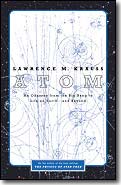ATOM: An Odyssey from the Big Bang to Life on Earth...and Beyond
By Lawrence M. Krauss

The Universe in an Atom - excerpt.
Many are called, but few are chosen. - MATTHEW 22:14
In the year 1281, the second Mongol invasion of Japan began, and ended. The invaders were defeated as much by the force of nature as by the Japanese warriors, as the Mongol ships suffered grievous losses due to the Kamikaze, or "divine wind". This routed the invaders and boosted Japanese pride in their island's invincibility, much as the storms that helped repel the Spanish Armada from British shores 307 years later —immortalized in a commemorative medal with the words "God Blew, and they were"—helped affirm the sense of Divine Right harbored by Mother England for centuries thereafter.
Those Mongol ships that survived the crossing of the Sea of Japan may have noticed the range of mountains that rise sharply from the water near the town of Toyama. These are known by some as the Japanese Alps—a popular skiing attraction today. Deep below these snowy peaks, where the sun never shines, indeed has never shone, may lie the secret of our existence, forged from a fiery wind, not necessarily divine, but more intense than any that has ever swept the Earth and as old as creation itself.
In the deep Mozumi mine in the town of Kamioka lies an immense tank of pure, clear water, recycled daily to remove contaminants. Forty meters in diameter and over 40 meters high, the Super-Kamiokande detector, as it is known, containes 50,000 tons of water—enough to quench the thirst of everyone in a city the size of Chicago for a day. Yet this device, located in a working mine, is maintained with the spotless cleanliness of an ultra-purified laboratory clean room. It has to be. The slightest radioactive contaminants could mask the frustratingly small signal being searched for by the scores of scientists who monitor the tank with 11,200 phototubes—eerily resembling television tubes—lining the outside of the tank. If the scientists' attention wavers for even a second, they could miss an event that might not occur again in the lifetime of the detector, or the scientists. A single event could explain why we live in a universe of matter, and how long the universe as we know it may survive. The signal they are searching for has been hidden for at least 10 billion years —older than the Earth, older than the sun, and older than the galaxy. Yet compared to the timescale of the process behind the event being searched for, even this stretch is just the blink of a cosmic eye.
We are about to embark on a journey through space and time, traversing scales unimaginable even a generation ago. A tank of water located in the dark may seem an odd place to begin, but it is singularly appropriate on several grounds. The mammoth detector contains more atoms —by a of 1 billion or so—than there are stars in the visible universe. Yet amid the 10 (1 followed by 34 zeroes) or so identical atoms in the tank is a single oxygen atom whose history is about to become of unique interest to us. We do not know which one. Nothing about its external appearance can give us any clue to the processes that may be occurring deep inside. Thus we must be ready to treat each atom in the tank as an individual.

The vast expanse of scale separating the huge Super-Kamiokande tank and the minute objects within it is a prelude to a voyage inward where we will leave all that is familiar. The possible sudden death of a single atom within the tank might hearken back to events at the beginning of time.
But beginnings and endings are often inextricably tied. Indeed, each Sunday one can hear proclaimed loudly in churches across the land: "As it was in the beginning, is now, and ever shall be, world without end." But do those who recite these words expect that they refer to our world of human experience? Surely not. Our Earth had a beginning. Life had a beginning. And as sure as the sun shines, our world will end.
Can we nevertheless accept this prayer as metaphor? Our world will end, but our world is merely one of a seemingly infinite number of worlds, surrounding an unfathomable number of stars located in each of an even larger number of galaxies. This state of affairs was suspected as early as 1584 when the Italian philosopher Giordano Bruno penned his De l'infinito universo e mondi. He wrote:
There are countless suns and countless earths all rotating around their suns in exactly the same way as the seven planets of our system. We see only the suns because they are the largest bodies and are luminous, but their planets remain invisible to us because they are smaller and non-luminous. The countless worlds in the universe are no worse, and no less inhabited than our Earth.
If, in the context of this grander set of possibilities, we contemplate eternity, what exactly is it that we hope will go on forever? Do we mean life? Matter? Light? Consciousness? Are even our very atoms eternally perdurable?
And so that is ultimately why our journey begins in the water in this dark mineshaft. If we explore deeply enough into even a drop of water, perhaps located in the Super- Kamiokande tank, we may eventually make out the shadows of creation, and the foreshadows of our future.
The water is calm, clear, and colorless, but this apparent serenity is a sham. Probe deeper —plop a speck of dust into a drop of water under a microscope, say —and the violent agitation of nature on small scales becomes apparent. The dust speck will jump around mysteriously, as if alive. This phenomenon is called Brownian motion, after the Scottish botanist Robert Brown, who observed this motion in tiny pollen grains suspended in water under a microscope in 1827, and who at first thought that this exotic activity might signal the existence of some hidden life force on this scale. He soon realized that the random motions occurred for all small objects, inorganic as well as organic, and he thus discarded the notion that the phenomenon had anything to do with life at all. By the 1860s, physicists were beginning to suggest that these movements were due to internal motions of the fluid itself. In his miracle year of activity, 1905, Albert Einstein proved, within months of his famous paper on relativity, that Brownian motion could be understood in terms of the motion of the individual bound groups of atoms making up molecules of water. Moreover, he showed that simple observations of Brownian motion allowed a direct determination of the number of molecules in a drop of water. For the first time, the reality of the previously hidden atomic world was beginning to make itself manifest.
It is difficult today to fully appreciate how recent is the notion that atoms are real physical entities, and not mere mathematical or philosophical constructs. Even in 1906, scientists did not yet generally accept the view that atoms were real. In that year the renowned Austrian physicist Ludwig Boltzmann took his own life, in despair over his self-perceived failure to convince his colleagues that the world of our experience could be determined by the random behavior of these "mathematical inventions."
But atoms are real, and even at room temperature they live a more turbulent existence than a farmhouse in a tornado, continually pulled and pushed, moving at speeds of hundreds of kilometers an hour. At this rate a single atom could in principle travel in 1 second a distance 10 trillion times its own size. But real atoms in materials change their direction at least 100 billion times each second due to collisions with their neighbors. Thus in the course of one minute, a single water molecule, containing two hydrogen and one oxygen atoms, might wander only one-thousandth of a meter from where it began, just as a drunk emerging from a bar might wander randomly back and forth all night without reaching the end of the block on which the bar is located.
Imagine, then, the chained energy! A natural speed of 100 meters per second is reduced to an effective speed of one-thousandth of a meter per minute! The immensity of the forces that ensure the stability of the world of our experience is something we rarely get to witness directly. In fact, it is usually reserved for occasions of great disaster.
You can get some feeling for the impact that tiny atoms can have on one another by inflating a balloon and tying the end, then squeezing the balloon between your hands. Feel the pressure. What is holding your hands back, stopping them from touching? Most of the space inside the balloon is empty, after all. The average distance between atoms in a gas at room temperature and room pressure is more than ten times their individual size. As the nineteenth-century Scottish physicist James Clerk Maxwell, the greatest theoretical physicist of that time, first explained, the pressure you feel is the result of the continual bombardment of billions and billions of individual atoms in the air on the walls of the balloon. As the atoms bounce off the wall, they impart an impulse to the wall, impeding its natural tendency to contract. So when you feel the pressure, you are "feeling" the combined force of the random collisions of countless atoms against the walls of the balloon.
Although this collective behavior of atoms is familiar, the world of our direct experience almost never involves the behavior of a single atom. But attempting to visualize the world from an atomic perspective opens up remarkable vistas, and gives us an opportunity to understand more deeply our own circumstances. The eighteenth-century British essayist Jonathan Swift recognized the inherent myopia governing our worldview when he penned Gulliver's Travels, which noted that the rituals and traditions of any society may seem perfectly rational for one who has grown up with them. Swift's Lilliputians fought wars over the requirement that eggs be broken from their smaller ends. From our vantage point, the requirement seems ridiculous. The same may be true for our view of the physical world, which is colored by a lifetime of sensory experience.
And so, as we approach the beginning of our oxygen atom's journey forward, we have to stretch our minds in the tradition of Swift. The atoms getting thrashed today in a drop of water may have a hard life, but this can't even begin to compare to the difficulties associated with their birth. To imagine these moments, we must go back to a time before water existed in the universe. We must venture back to when things were vastly more violent, back to a time more than 10 billion years ago, and perhaps less than 1 billionth of a billionth of a second after the beginning of time itself. We must visualize the universe on a scale that is so small, words cannot capture it. Indeed, we must go back to a time when there were no atoms ...or Eves.
About Lawrence M. Krauss
Lawrence M. Krauss' books











